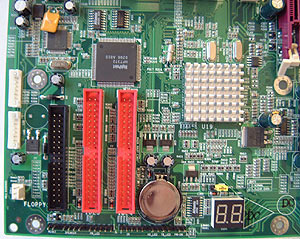Epox's attention to detail is something that we're really impressed with. When
installing the motherboard, you won't have to refer to the motherboard manual
when connecting the front panel LED's or switches. Epox also positions all
the USB and IEEE 1394 at the bottom of the motherboard. This way the cables all
stay at the bottom of the case and should l not get in the way of the other
devices.

There's not much to complain about with the 4SDA5+, but we would have liked
to have seen hardware based on board audio rather then the CPU
sapping AC'97 codec. Gamers and audiophiles will definitely have to buy a PCI
based sound card for a system based on this board. Most motherboards in
the 4SDA5+'s class also have on board Serial ATA, so it would have been nice if
that were supported as well. Sadly, it is not.
My biggest complaint about the 4SDA5+ revolves
around a setting in the BIOS which makes it currently impossible to set the
AGP/PCI speeds. I know when I'm aiming for a high new 3DMark score, I always set
my AGP speed to the highest possible value.
A bit on IDE RAID:
IDE RAID 0 is not really considered a
true RAID since there isn't any data redundancy. RAID 0 takes two drives of the
same size/configuration and stripes them, meaning it makes one big drive out of
two equal ones. This improves performance by cutting hard drive latency in half.
Since the data is divided equally and written on two hard drives it also
increases the data bandwidth by two. The reason it's not considered true RAID is
because if one drive fails, all data is lost.
IDE RAID 1 on the other hand mirrors two
drives of the same size, so in theory if one drive fails, the other will take
over as the primary hard drive and the system can continue to operate normally.
This is what is supposed to happen with a SCSI hard drive setup and it actually
works pretty well there.
The IDE subsystem doesn't allow hard
drives to be disconnected while the computer is still powered up and in use like
SCSI can unless you have a special HDD tray. Generally, when one IDE drive fails
the system usually locks up anyway. The data is safe since it's mirrored on the
other drive which is the real benefit.
With IDE RAID 0+1, you need four
hard drives of the same configuration/size. What RAID 0+1 does is
stripes two sets of two hard drives, one set for a RAID 0 configuration and the
other for RAID 1. What this does is offer the best of both worlds, the high
performance of RAID 0, with 100% data redundancy of RAID 1. Hence the name RAID
0+1. The only downside would be the need for four identical hard drives.
